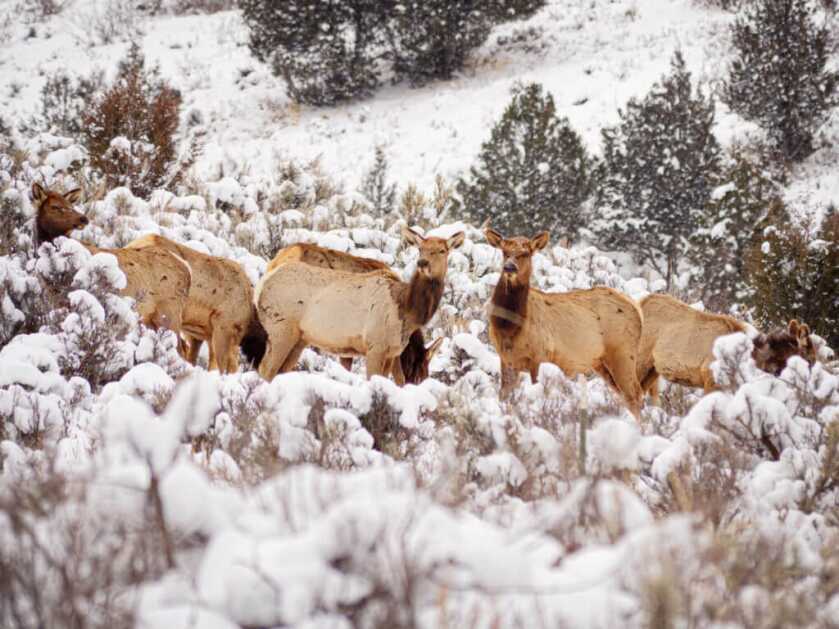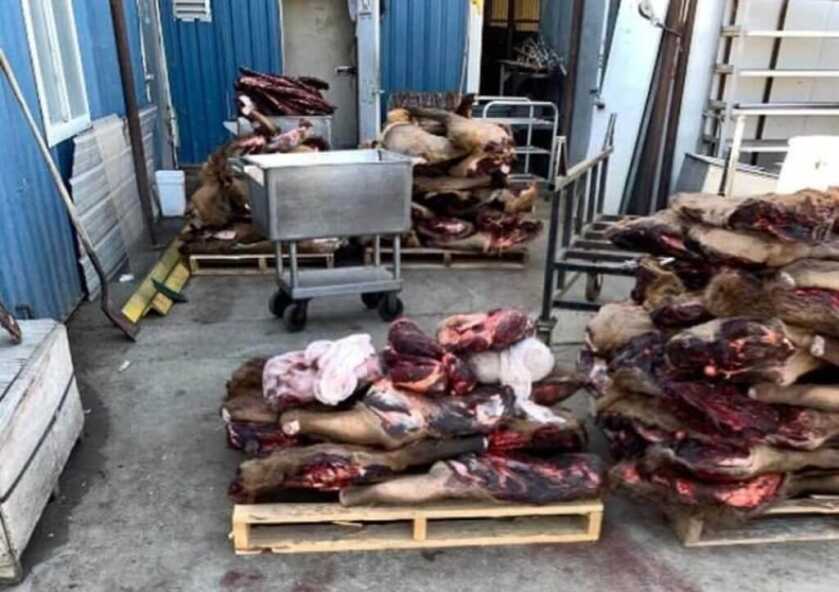
There’s a been a lot of furor about Idaho’s Department of Fish and Game killing 206 elk that were causing trouble for private landowners. A lot of hunters are upset because they feel the Department handled this irresponsibly at a time when hunter success is low, while others feel it a waste of meat. We spoke with Fish and Game’s Craig White, regional supervisor for the Magic Valley region, to clarify what happened and what it means for hunters.
Depredation Study
According to their about page, “Idaho Fish and Game’s mission is to protect, preserve, perpetuate and manage Idaho’s wildlife resources.” A big part of their time is spent mitigating wild animals’ impact on private lands. When elk are depredating private lands, it can feel like a literal attack. The department has many tools they can use to manage depredation by wildlife, including killing animals themselves or via depredation hunts.
However, the effectiveness of various depredation tools had never been studied. In 2018 and 2019 a study was conducted by a graduate student at the University of Idaho who is also an employee of the Department. Four ideas for managing depredation were being tested.
- Targeted lethal removal
- Fence modification
- Using trained hounds
- Applying taste repellants
The study was testing the efficacy and required frequency of each of these methods. The results are being analyzed now and will be applied to future efforts.
The targeted lethal removal is the one that gets everyone so excited.
Hunters’ Reactions
“My first impression? I was mad,” said Dirk Durham, a long time elk hunter and Idaho resident. “In northern Idaho, our herds aren’t meeting population objectives, and to hear that they are using lethal methods in other places doesn’t make sense. Why not transplant them?”
Transplanting is a reasonable option, but not part of the study being conducted.
Others were outraged about a picture they saw posted on Facebook. The image shows the legs of many elk stacked on pallets, which makes people feel that the meat is not able to cool properly and will be wasted.

In fact, according to White, the quarters on these pallets were already frozen and are awaiting processing. More on that below.
Depredation Hunts
Hunters can apply for depredation hunts each year in each of the state’s regions. Applicant’s names are randomly ordered on a list and they are called upon when depredation tags are available. One thing that upsets hunters about the 206 elk in question is that they were not offered the opportunity for the depredation hunts.
To be clear, these 206 elk were not killed all at one time but were killed from July to October 2019.
In each case, the elk were on private land at nighttime. In Idaho, hunting at night is not legal. In fact, Idaho Fish and Game is not capable of allowing special cases where hunters could hunt at night. They are bound by the laws set by the state legislature and the Fish and Game Commission. That means that depredation tags would not have been an effective tool for these instances. That left harvesting by IDFG employees, which is legal.
What animals were targeted?
In all cases, antlerless animals were targeted for harvest. Another thing they were picky about was not shooting animals wearing GPS collars. The data from those collars are used in various studies, including the one about depredation.
Although antlerless animals were targeted, there were a few spikes and branch-antlered bulls taken. The shooters used powerful flashlights to illuminate their targets and that lighting doesn’t always make it easy to see antlers.
Interestingly, they did not use suppressors on their rifles. One piece of the study was the effect of noisy guns on the herds, so they used unsuppressed rifles. Incidentally, the shooters used .308s and 7mms.
Why Not Increase the Number of Tags?
Increasing the number of elk tags issued may help reduce the population and also reduce the impact of depredation by elk. The Fish and Game Commission issues population objectives for each area — the last was published in the 2014-2024 Elk Management Plan. When populations exceed the published objectives, IDFG can issue more tags to reduce the population.
That’s the situation in the Smokey-Bennett and Pioneer zones right now. That’s why IDFG issued 1,600 more antlerless tags for the Smokey-Bennet zone last year than the year before. These are all in South Central Idaho, which unfortunately doesn’t help Durham’s lack of elk in the north.
Craig White admits that just because you have an elk tag doesn’t mean you’ll kill an elk, but issuing more tags is still a tool they can use to manage populations.
206 Elk Slaughtered?
As a matter of fact, those 206 elk were slaughtered, and Idaho Hunters Feeding the Hungry donated the meat to food banks. The IDFG had a refrigeration unit onhand for the hunts, set to freezing. The animals were slaughtered on sight and frozen before going to a local meat processor for butchering.
The quarters on those pallets were already frozen and awaiting processing. That picture was shared in January, so being outside wasn’t detrimental to the meat, either. Idaho Hunters Feeding the Hungry estimates that 80,000 meals were provided from that meat (4oz servings).
IDFG is also bound by law to salvage the meat from such hunts. Most of these situations have come up before and have been provided for. The public could help by giving IDFG the benefit of the doubt before jumping on the social media bandwagon.
How Can I Get In On Depredation Hunts?
There are two ways hunters can take advantage of depredation hunts. First, you can sign up for depredation hunts. There’s a form in every Big Game Season and Rules book, or you can download the form online. Applicants’ names are put in random order on a list and called when needed.
Another good way to take advantage of depredation opportunities is by getting landowner permission. Landowners may be issued depredation vouchers which they can give to hunters to redeem for tags. White advises that those who hunt on private land should take extra care to be good neighbors. He says that many landowners are willing to let hunters help, but they should close gates and not cut fields with vehicles. They should talk about what the landowner will allow for access, and they should be willing to turn in hunters who abuse the privilege.
What Will Happen Next Year?
The trouble with doing science is that it often uncovers more questions than it answers. The results from the two-year depredation study are being analyzed and will be implemented to guide techniques IDFG will use this year. The Department is also working with the State Attorney General to better understand what options are available to them according to the laws of Idaho.
“We will continue actively listening and learning and being willing to make adaptations,” White says. “We’ll see what the research tells us and we will continue to use hunters wherever and however we can.”


The shooting at night is WRONG no matter who is doing the shooting. Sounds like big gov at work. Hunters need to take a STRONG stand. Again-the voting booth is our tool. Cut the head of the snake!
Gary
To apply for a tag in Colorado now, Colorado Parks and Wildlife has a new rule that you must buy a “qualifying” license. Meaning either a Turkey tag or small game license. EXTORSION! Making a person buy something they don’t want to buy is extorsion and robbery. Kinda like mob protection? My wife refused to apply last year and didn’t hunt. I bought the small game and fishing combo because I do hunt small game. Our grandson and his buddy applied and being from out of state really got ripped off. They both said never again! The area we all drew for had a large fire before season and ran most of the elk out of the public land onto private land. None of us tagged out or even saw any elk.
To make matters worse we have hunted deer in this area we live in for 30 plus years. We used to get deer tags at least every other year. There are so many deer in this area everyone has to dodge them on the way down the roads here. Now according to the preference points, we need to have 5 to draw a deer tag. I’ll be 73 before a draw another tag within the area I live.
Oh, but a 5 hour drive from here, in the chronic wasting disease areas we might be able to draw with qualifying licenses purchased.
Over the counter elk licenses are available, but hours from here. I’ve done the outfitter tent and pup tent hunts when I was young and then camper trailers. It’s more effort now and money and don’t know if I’ll ever hunt in my home state again.
A lot of other states are more hunter friendly and will look into this now.
Sounds like the democrats are behind this,cause, it is one sided
The swamp is in Idaho. IDFG are the only ones benefitting from these hunts. Corruption can be in many forms. I bet their freezers are full. Feeding the homeless in Idaho with elk, I call BS. I would be curious what the criteria is to target an elk for execution. 206 elk is a herd. Slaughtered in a 4 month period. Harvesting 206 elk in 123 days(July-October) is nothing short of a slaughter that was financed by the tax payers of Idaho. The equipment and manpower(Overtime) all provided by taxpayers. The people of Idaho have been swindled.
So, only state employees know how to use Wicked Hunting Lights for night shooting? LOL! What a crock
Legal, licensed hunters, should be first! otherwise who exactly are you managing for?
The problem with “Landowner depredation Tags” is that he landowners charge a fee for those tags. They call it a “trespass fee.” THe fee is usually very high. Except for the well-off, most hunters cannot afford such fee.
If the landowner has a depredation problem, I am more than willing to help but I will not be suckered into pay for helping them.
There are jurisdictions that make it illegal for landowners to charge for depredation hunts. In fact the game Branch will refuse to provide depredation hunts if the landowner charges for access to the property.
I refuse to contribute to landowner greed!